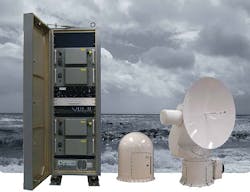Navy chooses shipboard data link from L3 Communications-West to communicate with UAVs
PATUXENT RIVER NAS, Md., 26 Jan. 2014. U.S. Navy shipboard unmanned aerial vehicle (UAV) experts needed a digital data link to control the MQ-8B and MQ-8C unmanned helicopters operating from the Littoral Combat Ship. They found their solution from L3 Communications-West in Salt Lake City.
Officials of the Naval Air Systems Command at Patuxent River Naval Air Station, Md., on Thursday announced a $17.6 million contract modification to L3 for surface terminal equipment for Hawklink Tactical Common Data Link (TCDL) and the Littoral Combat Ship, as well as for the Vortex Mini-TCDL Shipset components, to support the Fire Scout shipboard UAV.
The L2 T-series model-S surface terminal is a ruggedized communications terminal that has been integrated into the Littoral Combat ship and the Coast Guard National Security Cutter. The terminal is software configurable and supports standard CDL waveforms.
Related: Navy chooses AN/SRQ-4 ship-to-helicopter datalink radios from L3 for situational awareness
The system enables naval personnel aboard the Littoral Combat Ship to fly the Fire Scout unmanned helicopter remotely, and receive sensor information from the aircraft.
This terminal operates as part of a shipboard data link system or as a stand-alone, self-contained system for use in remote locations. The system consists of a 36-inch dual-axis antenna and a series of below-deck rack-mount line-replaceable units (LRUs) that contain the microwave modem assembly, MMA, CDL interfaces, and Ethernet options for open-systems interfaces.
The system fits into a half-rack space for a single-link configuration. It also has the option to use a portable computer for configuring and monitoring performance of the system, or may be integrated into a larger system application. The data link can be scaled to a multi-link configuration by adding LRUs and antennas.
Related: Next-generation Fire Scout unmanned helicopters to have increased range and payload
The antenna is self-contained and houses the RF power amplifier, diplexer, and receiver low-noise amplifier. This Ku band system is designed to operate in all weather conditions. The antenna can be remoted as far as 150 feet in the baseline configuration, L3 officials say.
The Northrop Grumman MQ-8B Fire Scout is an unmanned version of the Schweizer 333 turbine-powered manned helicopter from Schweizer Aircraft Corp. in Horseheads, N.Y., which is a Sikorsky Aircraft company. The MQ-8C is a larger unmanned helicopter based on the Bell 407 manned helicopter modified with autonomous controls from the MQ-8B.
The Littoral Combat Ship is a class of relatively small surface vessels designed to operate in shallow coastal waters and harbors. The ships are slightly smaller than Navy guided missile frigates, and have flight decks and hangars large enough UAVs and manned helicopters, can recover and launch small boats from a stern ramp, and can carry a small assault force with fighting vehicles. The ships emphasize speed, flexible mission module space, and a shallow draft.
For this contract modification L3 will do the work in Salt Lake City; Point Mugu, Calif.; Patuxent River Naval Air Station, Md., and should be finished by late this year.
For more information contact L3 Communications-West online at www2.l-3com.com/csw, or Naval Air Systems Command at www.navair.navy.mil.

